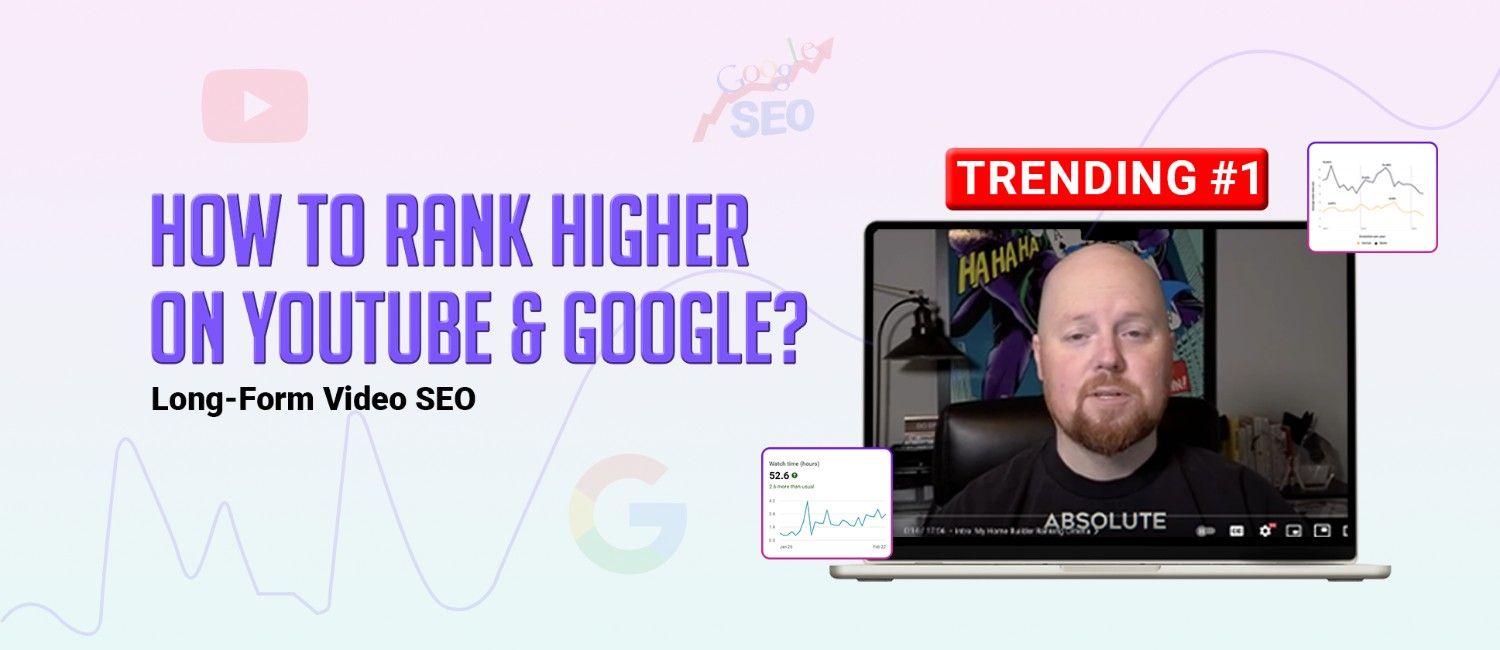Quick Summary
TL;DR: Long-form video SEO is becoming one of the strongest ways to rank on YouTube and Google in 2026. With the right chapters, transcripts, pacing, and metadata, long-form videos can dominate recommendations, appear in carousels, and even get cited by AI Overviews. #tldr
- Core Factors:
Watch Time → Retention → CTR → Structured Chapters → Transcripts → Schema → Engagement → Multilingual Captions
- What Will You Learn
How YouTube ranks long videos using watch time, CTR, audience retention, engagement, captions, and playlists → How multilingual captions, content repurposing, and AI-ready formatting help videos get more reach and citations
- Mistakes To Avoid:
Clickbait Titles → Ignoring Retention → Random Uploads → Auto Thumbnails → Skipping Comments → Ignoring Analytics
- Main Takeaway:
Well-structured, professionally edited videos with chapters, transcripts, metadata, and multilingual support can outperform short-form content and lead search results on YouTube, Google, and AI platforms.
Long-form videos are no longer just a way to share detailed content -they’re quickly becoming one of the strongest tools for search visibility in 2026. With YouTube acting as both a search engine and a social platform, and Google increasingly pulling video clips into AI Overviews, the competition for ranking long-form content is heating up. If you’re serious about growth, mastering long-form video SEO is essential.
The right approach can help your content stand out on YouTube’s recommendations, appear in Google’s video carousels, and keep viewers watching until the very end. To see how long-form is shaping video marketing overall, check out our breakdown of the Top 10 Long-Form Video Trends.
Why Long-Form Videos Still Matter in 2026
Many people assume shorter clips or short-form videos are the only way to hold attention online. But the truth is, long-form videos are performing better than ever when we do proper SEO and build their authority. In 2026, platforms are rewarding depth, not just quick hits.
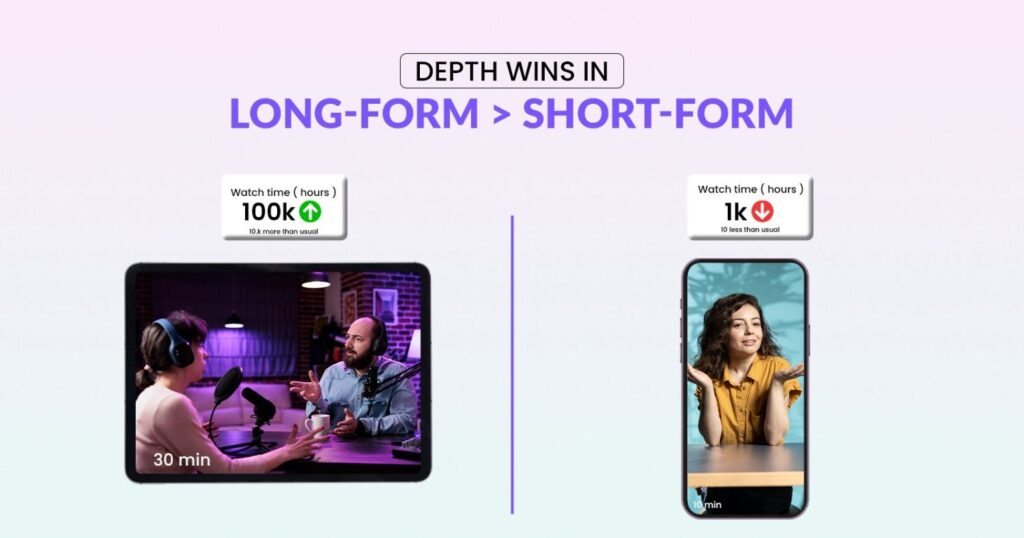
One major reason is YouTube’s algorithm, as it prioritizes watch time and retention. A 40-minute video that keeps viewers engaged for 30 minutes often outranks a short clip that loses attention in 30 seconds. This shift explains why YouTube has counted heavily on podcasts and “learning content.” People are spending more time watching breakdowns, tutorials, and long discussions that go beyond surface-level information.
Google is also following this trend. With the rise of AI Overviews, search results are pulling insights from longer, more detailed sources, including video transcripts. A well-structured long-form video with clear chapters and SEO-friendly metadata has a much higher chance of showing up in these summaries.
New Tubular Labs data shows that over 57% of YouTube’s minutes watched in 2026 (through May 31) came from videos longer than 20 minutes. It just goes to show that people and algorithms are really digging into detailed content these days!
Understanding Long-Form Video SEO
Long-form video SEO is not merely an extended version of short-form optimization. The criteria change once your content exceeds 10, 20, or even 60 minutes. Search engines and video platforms like YouTube assess these videos based on more than just keywords. They care about how long people stay, whether they interact, and if the video keeps them watching instead of bouncing away.
Unlike short clips, where a catchy title or trending hashtag can sometimes be enough, long-form videos demand consistency and depth. A great title might earn the first click, but it’s session duration, click-through rate (CTR), and engagement that determine whether your video ranks and resurfaces in recommendations.
Why Google and YouTube Algorithms Treat Long-form Differently?
Both Google and YouTube are designed to prioritize value. A three-minute highlight reel can entertain, but it’s not going to teach someone the way a well-structured, 30-minute tutorial or industry breakdown does. Algorithms reward that extra depth because it keeps viewers on the platform longer, which translates to more ad revenue and a stronger user experience.
Here’s what matters most for long-form SEO.
- Session Duration – If a viewer watches 15 minutes of your 30-minute video, it signals strong engagement to YouTube.
- Click-Through Rate (CTR) – Your thumbnail and title need to earn the click in search results.
- Audience Retention – Keeping people hooked with pacing, storytelling, and visuals ensures your video isn’t abandoned halfway.
- Engagement Signals – Comments, likes, and shares prove the content is worth interacting with.
This is also why many creators and businesses turn to professional editing support. A polished, well-structured video keeps viewers engaged for longer, directly boosting these SEO metrics. If you’re considering this route, ShortVids Video Editing Services can help optimize your long-form content so it’s not just watchable, but it’s competitive in search rankings.
Ranking Long-Form Videos on YouTube
YouTube is the largest video platform, and its algorithm rewards content that keeps viewers watching. Long videos can perform well, but they must be properly optimized and align with the latest trends. It’s not just about uploading a 30-minute video, but it’s about making sure the platform understands what your video is about and why it should be recommended.
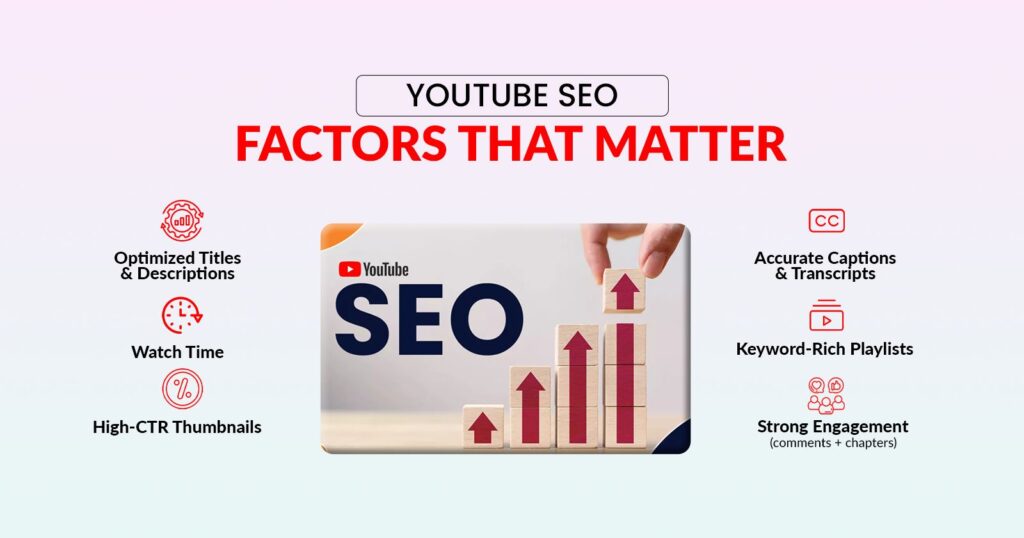
Core Long-form YouTube Video SEO Factors
Here are the main factors YouTube looks at when ranking long-form content, along with practical ways to optimize each one with SEO.
| Factor | Why It Matters | Action Tip |
|---|---|---|
| Title & Description | Signals relevance to YouTube search | Add primary + secondary keywords naturally |
| Watch Time | Still, the main ranking factor | Hook in the first 15 seconds and keep pacing tight |
| Tags & Playlists | Helps group content and extend viewing sessions | Add videos to playlists with clear, keyword-rich titles |
| Thumbnail CTR | A high click-through rate brings more traffic | Design custom thumbnails with contrast + curiosity |
| Captions & Transcripts | Improves accessibility and lets YouTube index the entire video | Upload accurate transcripts or auto-sync captions |
| Engagement | Signals quality and boosts recommendations | Encourage comments, likes, and use chapters |
The biggest mistake creators make is focusing solely on surface-level SEO, such as keyword stuffing in titles, while neglecting watch time and pacing. If your video feels stretched or unfocused, viewers drop off early, and YouTube picks up on that. We covered this in detail in our guide to Common Long-Form Mistakes, where poor editing and lack of structure directly hurt rankings.
Ranking Long-Form Videos on Google
Getting your long-form videos to rank on Google requires a slightly different strategy than YouTube. While YouTube looks heavily at watch time and engagement, Google focuses on how well your video answers a searcher’s question and whether it’s structured in a way that search engines can easily understand. Done right, long-form video SEO can help your content appear in carousels, featured snippets, and even AI-powered overviews.
Featured Videos & Carousels
Google surfaces videos directly in search results through features like Featured Videos and Video Carousels. Long-form content has a natural edge here because it’s more detailed and often covers multiple angles of a topic. To improve visibility:
- Add timestamps and chapters so Google can highlight key sections.
- Structure videos so each chapter can stand on its own as a mini-answer.
- Create descriptive titles for chapters that match common search queries.
When someone searches “how to start a podcast,” Google may highlight a specific timestamp within a 30-minute tutorial that explains microphone setup. That’s the power of structured long-form video SEO.
Schema Markup & Transcripts
Google’s crawlers need clear signals to understand your content. Using the VideoObject schema makes your video easier to index, and pairing it with a full transcript increases your chances of being cited in results. A detailed transcript not only helps with accessibility but also gives Google more text to match with search queries.
Here’s the official Google Developers guide on Video SEO.
| Google Feature | SEO Opportunity | Example |
|---|---|---|
| Featured Video | Be “the best answer” to queries | Tutorials, reviews |
| Video Carousel | Compete directly with peers | DIY guides, how-to walkthroughs |
| Video Snippets | Show thumbnail + transcript text | Podcasts, explainers, interviews |
If your long-form content is optimized with schema, transcripts, and chapters, it’s much more likely to be pulled into these rich results. That means more clicks, higher visibility, and stronger overall SEO presence on Google.
Advanced Long-Form SEO Tactics
Basic optimization gets your video discovered, but in 2026, the competition for visibility is tougher than ever. To truly stand out, long-form video SEO needs to account for how AI-driven search, multilingual audiences, and content repurposing are shaping digital strategy.
Optimizing for AI Overviews
With Google’s AI Overviews rolling out globally, search engines now prefer content that offers clear, step-by-step answers. Long-form videos have a natural advantage because they already provide depth, but the key is making that depth easy to parse:
- Add chapters with clear labels so AI can surface exact sections.
- Use a Q&A format inside your video, addressing common search queries.
- Pair the video with a transcript that mirrors the same structure.
When AI Overviews summarize answers, videos with structured explanations are more likely to be cited and linked back, boosting both traffic and authority.
Multilingual SEO
Audiences in 2026 aren’t confined to one language, and neither is search. Adding captions in multiple languages helps your long-form videos show up in global search results. For example, an English tutorial on editing can reach new viewers in Spanish or Arabic with accurate translations.
YouTube already allows multiple caption tracks, and pairing this with translated transcripts gives your content a serious advantage in non-English search queries.
Repurposing for SEO
Long-form video shouldn’t exist in isolation. By repurposing a single video into shorts, reels, or even written blog posts, you can create multiple entry points for your audience while building backlinks to the original long-form content.
This approach works especially well for turning complex sections into visual explainers. For instance, transforming a detailed segment into a standalone animation makes it easier to share across platforms. If you’re considering that route, check out our 2D Animation Services to see how visual storytelling can extend the reach of your long-form strategy.
AI Citations in Long-Form Video SEO
In 2026, AI citations are becoming one of the most important signals for visibility. As Google, Perplexity, and other AI-driven search tools summarize answers for users, they increasingly cite sources, sometimes linking directly to videos, transcripts, or even timestamps inside long-form content. For creators and businesses, this means long-form video SEO is no longer just about ranking in YouTube search or Google carousels, but also about being cited by AI.
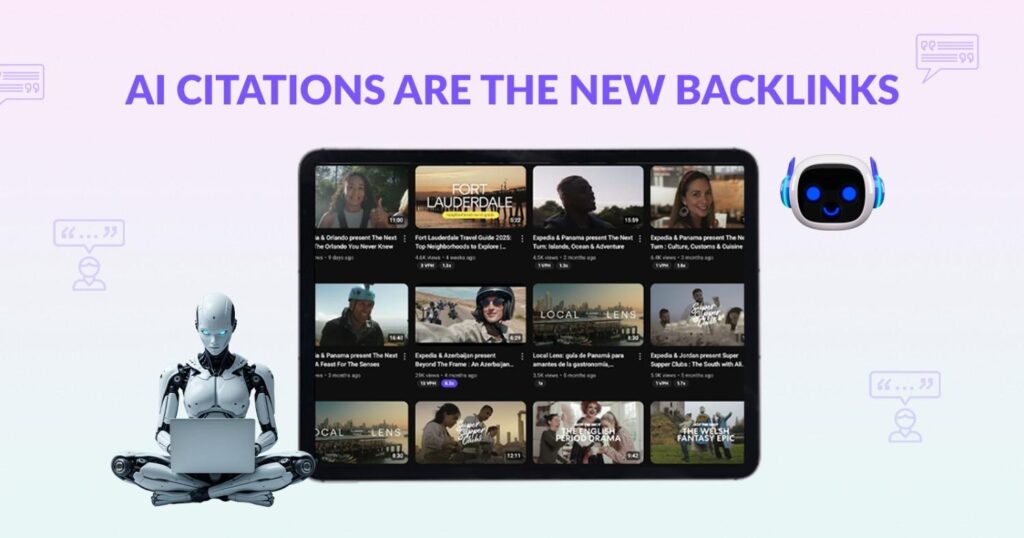
Why AI Citations Matter for Video SEO
- Trust & Authority – When an AI assistant cites your content, it positions your brand as an expert voice on the topic.
- Top-of-Funnel Visibility – AI results often appear before traditional organic rankings, putting cited videos directly in front of searchers.
- Traffic & Conversions – Citations include links back to the original source, driving highly qualified viewers to your channel or website.
How to Optimize Long-Form Videos for AI Citations
- Structured Chapters – Add keyword-rich chapters that match user queries (e.g., “What is audience retention in YouTube SEO?”).
- Upload Complete Transcripts – AI tools rely on text to “understand” your video, making transcripts critical for citations.
- Answer Questions Clearly – Use Q&A segments within your long-form video to align with natural language search queries.
- Schema Markup for Videos – Mark key moments and timestamps so AI systems can surface precise answers.
- Multilingual Captions – Expands citation opportunities across global search engines and AI platforms.
The Future of AI Citations in SEO
AI-powered search assistants are changing how people discover and trust information. Let’s say you publish a 40-minute tutorial on “How to Edit YouTube Videos for Beginners.” If your transcript includes a clearly labeled section titled “Step 1: Setting Up Your Editing Software,” Google’s AI Overview could directly cite that timestamp in its response when someone searches “How do I set up editing software for YouTube videos?”
This wins rankings and credibility. In 2026, AI citations are the new backlinks for long-form video SEO.
Measuring Long-Form Video SEO Performance
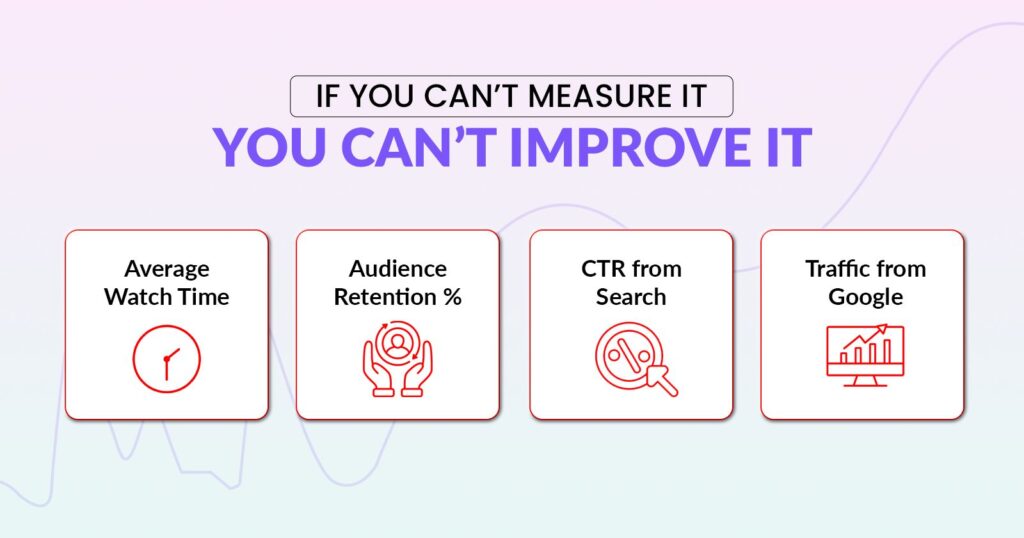
Creating great videos is only half the job. To know whether your long-form video SEO is actually working, you need to track the right performance metrics. The goal is to understand how viewers engage with your content and whether that engagement leads to meaningful results, such as increased traffic or conversions.
Key metrics worth monitoring include.
- Average watch time – Tells you how long viewers stay before dropping off.
- Audience retention – Shows whether people are sticking with your video or skipping sections.
- Click-through rate (CTR) – Reflects how often people click your video when it shows up in search.
- Traffic from Google search – Helps you measure visibility beyond YouTube.
- Conversions from embedded CTAs – Tracks if your videos are driving sign-ups, purchases, or leads.
For tools, start with YouTube Analytics to track watch time and audience retention. Google Search Console is great for spotting which queries surface your video in search results, and platforms like HubSpot dashboards can tie video performance directly to business outcomes.
A strong example of this in action is our Colin Matthew Case Study. ShortVids helped him break through stagnant growth by providing content scripts, hooks, podcasts, and repurposed long-form videos to surpass 25,000 YouTube followers.
By regularly reviewing these numbers, you’ll be able to refine your strategy, focus on what’s working, and adjust the parts that aren’t delivering results.
When to Get Professional Help For Long-form Video SEO
There’s a lot you can do on your own to improve long-form video SEO, but there comes a point where DIY has its limits. Editing, optimizing metadata, creating branded visuals, and setting up distribution can quickly become overwhelming, especially if you’re trying to scale content across multiple platforms.
Professional support makes a difference in three key areas.
- Editing and Pacing – A skilled editor makes sure your long-form videos are polished, well-structured, and engaging throughout.
- Brand Consistency – Consistent branding in your intros, outros, and graphics fosters recognition and builds trust with your audience.
- SEO Setup – The proper use of titles, tags, transcripts, and schema markup enhances the visibility of your videos in YouTube and Google search results.
If you’re ready to take your long-form video strategy to the next level, it may be time to work with a dedicated team. Professional help isn’t only about replacing your creativity, but it’s about giving your videos the technical boost they need to rank, perform, and convert consistently.
At ShortVids, we’ve structured packages to fit different needs, from creators just starting out to enterprises running multiple video campaigns. You can explore what’s included in each plan in our updated ShortVids Pricing Plans blog.
Final Thoughts
Long-form video SEO requires a strategy that focuses on engagement, optimization, and distribution, along with keywords. Brands that create well-structured, high-quality videos with clear chapters, transcripts, and strong storytelling will stand out as AI technologies advance.
If you’re ready to improve your rankings and maximize your video’s impact, contact ShortVids today to develop a tailored strategy for your audience and business.
Frequently Asked Questions
Video SEO is done by optimizing titles, descriptions, transcripts, and thumbnails, as well as adding schema markup and timestamps. For long-form video SEO, focus on watch time, audience retention, and structured chapters, since Google and YouTube reward in-depth, engaging content.
Yes. Long-form content (both written and video) performs well because it provides comprehensive answers that keep audiences engaged. Search engines prioritize long videos that deliver value over time, making long-form video SEO an essential strategy for 2026.
Google doesn’t favor long-form content simply for its length – it prefers content that answers queries thoroughly. With long-form video SEO, adding chapters, transcripts, and structured metadata increases your chance of being featured in carousels, snippets, and AI Overviews.
Video SEO results typically take 4to 12 weeks, depending on competition, keyword difficulty, and content quality. For long-form videos, building authority through consistent uploads and viewer engagement accelerates ranking performance.
You can track your video SEO score using YouTube Analytics, Google Search Console, and third-party tools like TubeBuddy or VidIQ. These platforms reveal data on CTR, impressions, ranking keywords, and audience retention, all key signals for long-form video SEO success.
Popular tools include TubeBuddy, VidIQ, and Ahrefs for keyword research. YouTube Analytics itself is invaluable for tracking watch time, CTR, and retention, the most critical factors in ranking long-form content.
Tags have less influence than before, but they still provide context. While not a primary ranking factor, they help YouTube better categorize your video.
Book a Call Today
- Fixed monthly plans starting at $999
- 24-hour turnaround time (or less) on all short-form edits
- 3-layer quality check system on every video
- No more chasing freelancers or managing editors
- Scale up to 50+ videos/month without hiring in-house
- Content team trained on platform trends, scroll-stopping hooks & storytelling
- Fully managed by professionals – you just upload & approve
- Response time: Under 1 hour (US & GCC time zones)
Cut your production costs, not your standards.

